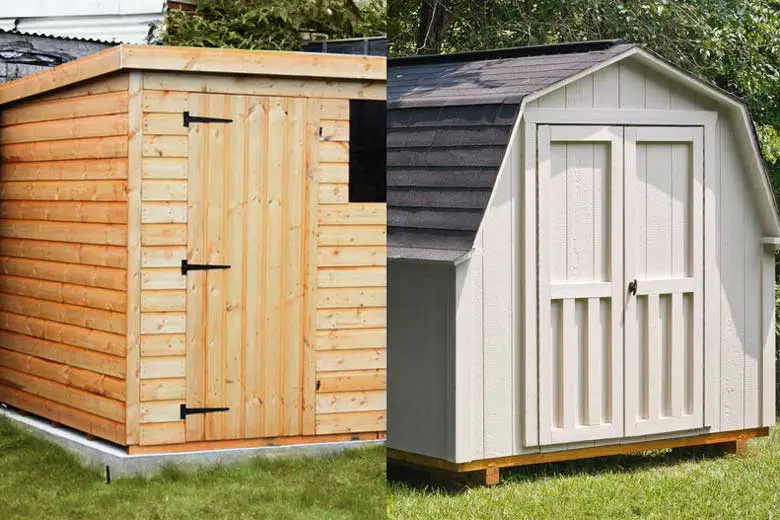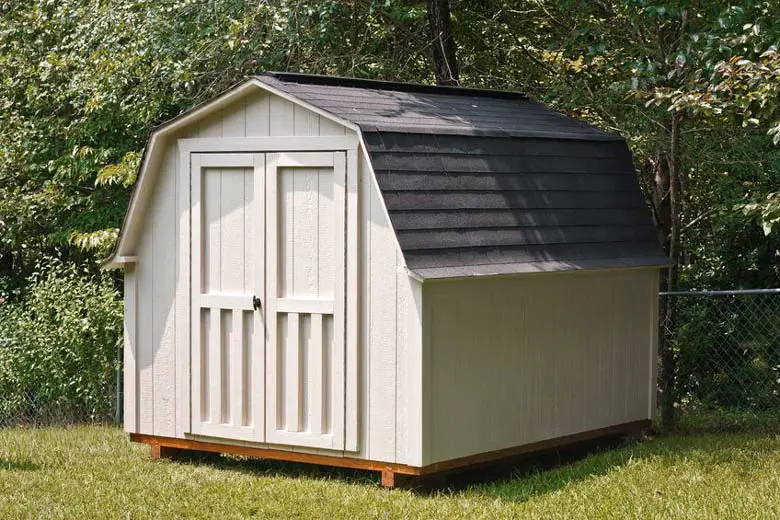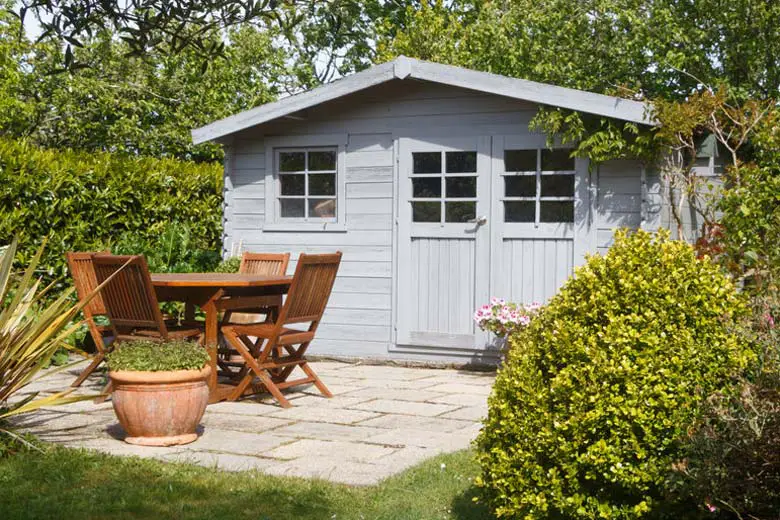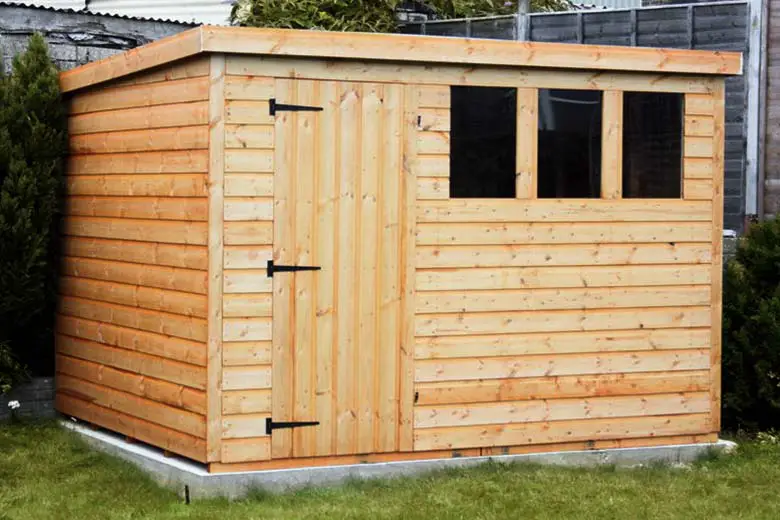A garden shed is a great way to extend the living or storage space of your property. It can increase your home’s functionalities and give you extra room for your hobbies or enjoy your downtime. When building the perfect shed, its foundations can make a difference between a stable structure and an unreliable shed!
Wood is a better foundation for a shed that does not have to hold much weight, as it’s easily removable, affordable, and easy to install. For concrete foundations, you might need planning permissions, and they can be difficult to remove. Concrete is more suitable for garages and heavier structures.
If you want to build a shed in your garden, you need to start with the foundation. The differences between concrete and wooden shed foundations will be discussed in this article, as well as the other types of shed foundations.

Table of Contents
Wood vs. Concrete Shed Foundation: Which One To Choose?
A garden shed can be a great way to increase your property’s value, enlarge your home’s storage space, and have an extra room to enjoy sunny weekends outdoors. However, building a shed can be a delicate project, and a shed’s foundations, or its base, can make a difference in the structure’s reliability.
Before diving into the details that set wood and concrete shed foundations apart, it is essential to understand the two’s main differences.
- Wooden shed foundations are ideal for lightweight sheds for your garden tools or to create an extended living space in your backyard. They are easier to install than concrete foundations and won’t require planning permissions.
- Concrete foundations are permanent and difficult to remove even after decades. While they often require planning permission, they are more suitable if you are building a garage, as concrete foundations can withstand the weight of a vehicle.
Whether you prefer a permanent or temporary foundation, you will need either a wooden or concrete base. You’ll want to think about your shed’s use, the type of structure, and ground quality before choosing the foundation type you need.
Aside from wood and concrete shed foundations, there are several other options, including gravel and slabs. You can find out more about wood and concrete shed bases in the sections below to help you pick the best one.
Wood Shed Foundation: A Temporary Base
A wooden shed foundation is an optimal choice if you want a temporary option for your shed. When opting for a wooden base, you will need to make sure that there is plenty of space around the shed for assembly and maintenance of the structure.

Of course, you must be clear on what you’re planning to use the shed for. If you need some space to store your tools, the shed’s base won’t need to be so sturdy.
However, if you create a structure large enough to house a parked car, you will need a concrete foundation that is strong enough to support the weight of the structure and the vehicle.
In any case, it is recommendable only to use pressure-treated hardwood or timber. Pressure-treated timber, or tanalized timber, is a timber that undergoes a special chemical treatment, which increases the wood’s life expectancy and makes it resistant to moisture, mold, rot, fungi, and insect attack.
When creating a shed base made of timber or hardwood, you should remember that the structure will be higher than the ground. So, you might have to build steps to access the shed, which can make moving tools and machinery such as lawnmowers more challenging.
In the video below, you can learn more about building a wooden shed base:
If you still doubt that a wooden structure is the right one for you, learn more below!
When Should You Use a Wooden Base?
Wood is not the sturdiest material when it comes down to creating a base for your shed. The panels will be living in moist grounds, making them subject to rotting and insect attack.
However, there are some instances in which using wood might be the most suitable option, such as:
- If you want a temporary, easy-to-install solution
- If your wooden shed does not have to hold a lot of weight
- If you don’t have the necessary planning permission for a concrete base
- If your shed is a prefabricated model without floors
A wooden shed base is extremely lightweight and suitable to build a temporary shed on rented properties.
Types of Wood Foundation
If you believe that a wooden foundation for your garden shed is the right option for your needs, you need to find the best wooden structure type. Here are some of the best options:
- Timber battens: Timber battens might be the most affordable and minimalist way to create a shed base. However, battens tend to move and adjust when in the ground, making the shed less stable.
- Pressure-treated frame: While you can install these frames by yourself, they are professionally designed to be a stable shed base. They sit a few inches above the ground, and they are pegged into the soil. Once leveled, they will create a stable structure for your shed while also allowing for airflow, which can make a difference in the wooden structure’s life expectancy.
- Timber decking: Timber decking is a platform-like structure that supports your prefabricated shed. It often sits a few inches off the ground level, and it is suitable for heavier facilities. Make sure to use pressure-treated timber for this structure.
Benefits of Wood Foundation
Wooden shed foundations are extremely popular choices because they yield considerable benefits over a concrete base.
- Temporary: Wood foundations can be easily moved and removed when you no longer need them.
- Lightweight: They are easy to reposition around the garden and can be easily handled by anyone.
- Accessible: When installing a wooden foundation, you won’t need to worry about obtaining planning permission.
- Airflow: Located above the ground, frames and decks allow for a consistent airflow that can maintain the shed’s wooden structure intact for longer.
- Affordable and easy-to-install: Whether you have opted for a DIY structure or a pre-designed kit, wooden decks will rarely require you to hire a professional for installation.
- Suitable for sloped grounds: Wooden bases sit above the ground, which means you can counteract any slope on the floor by adjusting the peg’s length.
Drawbacks of Wood Foundation
While a wood foundation is a popular choice for many reasons, it can also have some disadvantages that might make you reconsider a wood foundation.
- Subjected to rotting: Especially in the case of untreated timber, it is likely that you will start noticing rotting, insect attacks, and molding on your posts and deck.
- It can be unstable: A timber batten structure can move in the ground once you have laid down the different pieces, which can make the shed structure unsafe.
- It can hold limited weight: If you use your shed for tools, a wooden base will be an excellent choice. However, if you are storing furniture, machinery, or vehicles in the shed or garage, you might consider a concrete foundation.
Concrete Shed Foundations for a Permanent Base
Another excellent option for your shed foundation is a concrete base. If you own your property and want to build a long-term structure, a concrete base might be the right choice for your needs.

With a concrete base, you won’t have to worry about common issues that affect wood, including rotting and insect infestations.
Additionally, concrete can hold the weight of a heavier shed structure, vehicles, or machinery, without bending. However, concrete will often crack after a while due to the weather or the concrete’s quality when it was first poured.
If you have opted for a large shed built on-site rather than a prefabricated one, you might also opt for a concrete base. If your shed does not come with an integrated base, a concrete foundation might be the best option to ensure insulation and avoid rotting.
When opting for a concrete shed foundation, you’ll want to keep in mind that the ground needs to be adequately prepared to be level and even.
Also read: Concrete Thickness for a Garden Shed
In the in-depth video below, you can learn about creating a concrete foundation and a shed from scratch:
When Should You Use Concrete?
Creating a concrete base for your shed is not a decision that should be taken lightly, as a concrete foundation is not easy to remove once in place.
Additionally, the process of building a concrete floor can be lengthy. Not only will you need planning permissions, but you will also need to hire a professional contractor who can install the shed base.
Concrete foundations cannot be moved or adjusted after they have been put in place, so even a minimal incline can cause your shed structure to be unreliable.
If you are unsure which one to choose between concrete and wooden foundations, bear in mind that concrete slabs are more suitable for:
- A permanent structure
- Large, heavy sheds
- Sheds without a pre-built floor
- Sheds that serve as a garage and need to hold the weight of several vehicles
Types of Concrete Foundation
As we have seen, concrete makes for the most stable, durable base for a shed. However, there is more than one option you might consider when laying the foundations of your structure.
- Concrete blocks: Concrete blocks are relatively easy to move and maneuver, and you can pair them with a timber structure, and come in square or rectangular blocks that can be set up directly on the ground. They must be made of solid concrete and at an even level.
- Concrete slab: A concrete slab is the longest-lasting base structure you could opt for for your shed. While you might need professional help to set up your concrete slab base, it will only require minimal maintenance.
Read more: How To Pour a Concrete Slab: The Ultimate DIY Guide
Benefits of Concrete Shed Foundation
A concrete shed foundation is an excellent option for a longer-lasting structure. Some of the benefits of this choice include:
- Durable and resistant: Concrete can withstand the weight of multiple vehicles or different pieces of machinery.
- Resistant to mold and rotting: With sealed concrete, you won’t need to worry about the issues that usually affect wooden structures, including moisture, humidity, and insect damage.
- Perfect for sheds without a built-in floor: While prefabricated structures might come with a wooden floor, sheds built or assembled on-site might not have one. The cement can protect the walls, side panels, and entrance of the shed.
- It can be a DIY project: While two people might be required, you can easily create a concrete base by yourself as a weekend project, which can cut down the cost of building a concrete foundation.
Drawbacks of Concrete Shed Foundation
If you are building a larger shed or planning to use it to house vehicles and materials, a concrete floor might be the only option. While it allows you to count on a sturdy base, some drawbacks of concrete are worth keeping in mind:
- It can be expensive: The cost of concrete varies depending on how easy it is to access the site, the cement quality, and the size that needs to be covered. However, this is generally considered one of the most expensive ways to create a shed’s foundations.
- It can be labor-intensive: Unlike wooden structures, you will likely need at least two people to handle cement slabs or blocks correctly. Since mistakes can be irreversible, it is recommendable that you have previous construction and DIY experience.
- It is permanent: It can’t be easily removed or relocated, even decades after the original construction. The shape created will be definitive, and any error in the building might be difficult to rectify.
- It might require planning permissions: While you might not need permission to set down concrete blocks, you might require them to create a concrete slab. If in doubt, you should always get in touch with your local planning authority.
- It is not the most environmentally friendly choice: Concrete is not a natural material and can disrupt your garden’s ecosystem and is not easily recyclable. You might need additional permission if your property is in a protected area or National Park.
Wood & Concrete Shed Foundation: Decking Block Shed Base
It can be challenging to determine whether the perfect shed foundation for your needs is, as you need to consider several factors, including the size of your garden, the location of your property, and the use you will make of the shed.
However, there are considerable drawbacks of both options, which might make you rethink your choice. In this case, you might consider installing a decking block base, which uses the features of concrete and wood, counteracting their downsides.

So, if you want to make the most of these two materials, a decking block might be the right option for your needs. This structure is composed of a wooden frame located on concrete blocks.
Some of the benefits of this hybrid solution include:
- It is ideal for creating an even platform on sloping grounds.
- The blocks protect the shed from moisture damage and damp soil.
- The battens located on top of the blocks create an even platform for your shed.
Ultimately, this option allows you to create a structure that is durable and more resistant than wood. However, it is still lighter and more mobile than a concrete slab.
Other Shed Foundation Options
Wood and concrete are excellent materials to build your garden shed’s foundations. However, they are not the only choices. You might find that some other materials better fit your garden’s specific needs. In the section below, you can find some tested alternatives that are worth considering.
Gravel
Gravel is an excellent option for a shed’s foundation, as this material is inexpensive and suitable for prefabricated structures that come with an integrated floor.
Gravel is best suited for slightly uneven ground that sits mostly level, as it might not counteract a sloping surface.
Additionally, gravel offers some benefits that might make it more preferable than concrete or wood for your garden shed:
- Drainage: Gravel provides a lot of drainage beneath the shed, which can prevent rotting or molding. When it rains, the gravel will absorb the water and transfer it to the soil. Concrete can’t absorb water, while wood might rot.
- Cheap and easy to install: Gravel is among the least expensive materials for your shed’s foundations and can be set up without professional help.
- It can easily be removed: Gravel provides a base as strong as concrete, but it is much easier to transport, relocate, and clear.
If you wish to use gravel, but your garden is on a slope, you might consider creating a timber structure containing the gravel and creating a level surface.
Paving Stones
Paving stones or slabs have always been the most common option for the shed’s foundations, as they are effortless to install, and can withstand as much weight as concrete. Therefore, whether you wish to use your shed as a garage or hold your gardening machinery, these paving stones can be the right choice.
They are not as environmentally friendly as wood might be, but they can last for much longer, reducing environmental waste. Before setting up these stones, you will have to prepare the ground by leveling it, removing any turf, and adding coarse sand.
Since these stones are heavy to lift and move around, you might require another person’s assistance when setting them up on the ground.
Additionally, make sure that the soil underneath is even and solid to prevent the stones from moving. You’ll want to avoid the area underneath trees where the roots can move the ground and lift the paving stones.
Plastic Grid System
PVC grid systems are not an environmentally friendly way to create a base for your shed. However, if you want to have the same effect as paving slabs without repositioning the cumbersome stones, this solution might be perfect for your needs.
The benefits of a plastic grid system include:
- It is resistant to damp soil, moisture, rot, and water damage.
- It is heavy-duty.
- It can withstand heavyweight items.
- It allows airflow underneath the shed, which can keep the wood dry and protected from rotting.
- They are easy to maintain, lightweight, and long-lasting.
When selecting a plastic grid system for your shed base, make sure you have a solid floor where you can set up each piece. Additionally, it is recommendable to select larger squares that will move around and settle less.
Using an Existing Surface
If you want to keep the costs low, think about using an existing surface. For example, if there is a location around your house that already boasts a paved floor, you might consider setting up a prefabricated shed there.
When doing so, it is vital to check that the floor can withstand the extra weight. Additionally, you might consider speaking to a professional to get an understanding of the soil quality, as even a minimal slope can ruin your shed.
Think about where you wish to position the shed, as it should not prevent access to any facility and should not be underneath drains and other service points.
Where To Place Your Shed Foundation
It is impossible to decide on the correct type of foundation without selecting the right spot for your garden shed because if you opt for a level surface, gravel or plastic grids might be enough to guarantee you a solid base for the whole structure.
However, if your garden is on a slope, you might need to upgrade to a concrete base.
Here are five primary considerations for anyone who is about to build their first garden shed to find a perfect location.
Find a Level Surface
Finding the right location for your shed can make a difference in the result. If you have a large garden, try to find a level spot. While this is not strictly necessary, it can help you avoid having to build a flat terrace for your shed.
In turn, you might be able to use paving stones or a plastic grid directly on the ground, which can save you money and effort.
Drainage and Airflow
Your shed base needs to have proper drainage as water and moisture are likely to infiltrate underneath the shed. Without adequate drainage and constant airflow, it is easy for this moisture to damage the shed’s sidewalls, making the whole structure unsafe.
Concrete is among the most durable materials for foundations, but it does not provide drainage. Oppositely, gravel or plastic grids allow water to flow through the surface and return to the soil.
Instead, you might consider creating an elevated structure that allows air to pass underneath the shed and dry out any wooden part.
Find a Location Away From Foliage
Plants, shrubs, and vegetation are essential parts of the landscape and truly enhance your garden’s design. In the summer, the shade they provide is a great benefit.
However, parts of the soil that are constantly in the shade are likely to remain damp and will not dry properly. Setting up your shed in such a location might increase the chances of moisture and water damage, especially if you have created a wooden base for the shed.
Accessibility and Light
While the shed needs to be at a considerable distance from the house, it needs to be in an accessible location that receives plenty of natural air and light. These features allow you to work in the garden or enjoy your afternoons outside without resorting to artificial light.
In terms of accessibility, make sure that the shed’s base is not so high off the ground that it becomes challenging for you to lift machinery and tools in and out of the structure.
Consider Electricity Needs
If your shed is also designed to be your workshop or garage, you might need electricity, not only for lighting but also for powering your tools. Placing the shed’s foundation near an electrical source might be a good idea.
Or, in some cases, you might create a simple electric system inside the shed which is connected to your home’s system. If you wish to do so, your shed base’s location will be dictated by the power line’s location.
However, if this is not possible, you might consider adding solar panels and create a stand-alone system that allows the shed to be fully functioning at all times.
DIY or Professional Shed Foundation?
Undoubtedly, you will want your shed to be built well and tailored to your needs. However, not many homeowners wish to spend a lot of money on building a non-essential shed.
When creating a base for your garden by yourself, you need to have some construction experience and the necessary tools. If you have opted for a concrete foundation or paving stones, you might also require a friend or family member’s help.
If you are unsure about the proper process to bring to life your dream shed, you should not attempt to build one by yourself.
Conclusion
The base is potentially the most crucial aspect to consider when building a shed. You could use several materials to create your shed’s foundations, including gravel, plastic grids, and paving stones. However, the most common types of shed bases are concrete slabs and timber battens.
Concrete is longer-lasting and able to withstand multiple vehicles’ weight, but it requires you to obtain planning permission and be labor-intensive. A wooden structure is lightweight and temporary but not suitable if you think of using your shed as a garage.



